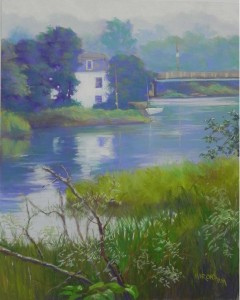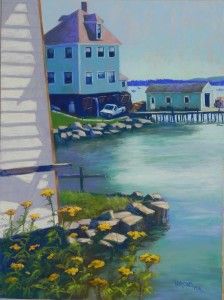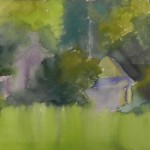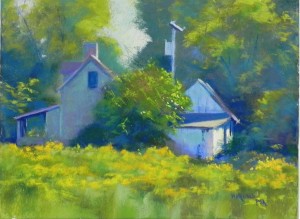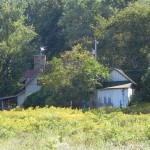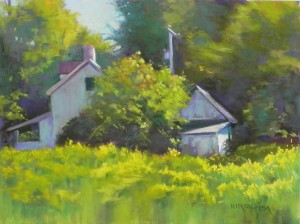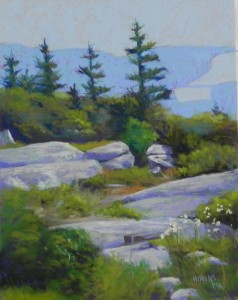This second painting of Maine is from a trip in 2009. This was shot inland, somewhere near Rockland. I’m hoping to figure out where it was and perhaps use the name of the river in the title. For this painting, I decided to use watercolor as an underpainting. It worked very nicely in the top part, not quite as well, but OK, at the bottom. I used violet and used varying degrees of color to lay in the layers of trees in fog. It was an overcast, misty day and I loved the quality of the light. For the sky, I began with light violet, then used the lemon yellow Art Spectrum tinted white pastel, which is one of the most useful I have! I used a combination of violets and greens in the trees. I made up the boat and showed a lot more of the house than what was in the photo. I left out overhanging branches in the upper right corner, but kept in the lower branches, which I really liked. I wanted this to have a sense of softness and mystery. Used some finger blending in the water. I really enjoyed doing this painting and once again painting over watercolor on Pastelbord.
Monthly Archives: October 2015
Stonington Blues
I’ve been painting Maine! Knowing that I’ll have paintings in a gallery in Blue Hill and also that ArtBlend wants New England scenes for the Art Hamptons Art Fair in July is giving me a lot of energy to paint! Stonington Blues is based on a photo I took this summer. I saw and filmed this house and wharf building from many angles, but I liked this one best. I love the idea of peaking around a corner and seeing the house, truck and shed. There was a deck attached to the building at left that was covering much of the house. Fortunately, I had another shot of it that revealed what the house looked like. I simplified the foreground by removing the deck and a lot of litter in the “yard”! I began the picture with a hard pastel and alcohol underpainting, using oranges, browns, and some violets underneath. I used orange in the sky and left small pieces of it showing through. I warmed up the roof of the house with reds, but kept the roof of the shed as it was (loved it!). What I really love are the different colors of the blue house and more teal-colored shed. The sky, background islands, and water added additions blues and blue greens. I used a dark blue for the deepest shadows among the rocks and the base of the house. I limited violets to the roofs and parts of the water and white building at left. The yellow flowers at the bottom added an important touch of color.
Stonington Blues, 24 x 18, Pastelbord
Catching the Light #2
I did a demo and discussion for my class today on creating a “useful” underpainting. My original intention for this was to do my usual hard pastel and alcohol underpainting and discuss color choices. As noted in an earlier post, I realized that this subject matter would lend itself nicely to a center of interest approach with a watercolor underpainting. My newer students have never seen me do a watercolor underpainting and it’s not something I’ve done in a long time! I went through my “Richard McKinley phase” some years ago, trying to apply watercolor to gatorfoam and other surfaces on an upright easel. A few of them were successful, but on the whole, I decided it wasn’t for me. I was a “big shape” painter and hard pastel worked better. Doing this painting today was a revelation and sheer joy! But I made some changes from past practice.
I worked on Pastelbord (white) and I worked flat when applying the watercolor. I didn’t want it to run down and pool at the bottom. I found that the surface didn’t take it very well immediately, then realized that it took it if there was enough water in the brush. I could have added more but didn’t want to take the time. I had to use the hair dryer to dry it, unlike alcohol. What I learned from the past is that you have to be careful not to use heavy, dark applications of pastel over the watercolor. It doesn’t look right and you end up covering it all up. Giraults are perfect and I opted for lighter values than what I used in the first painting. What I discovered in layering the Girault on the board was that the surface hadn’t been compromised at all, as it is with the hard pastel, and I had a lot more grit to work with. It was great! I was in heaven!!! I worked more slowly, carefully, and sensitively (as Richard teaches), putting small pieces on and taking my time. I really loved how the colors layered and the light effects that I could get with the Girault. In a few places (to the left of the house on left) I left the watercolor with no pastel. In other places I applied it very lightly. I used the softer pastels on the shed and the goldenrod (using a yellow green and two yellow Blue Earth pastels).
I totally enjoyed the experience of doing this painting. If you compare it to the first iteration, you will see that the colors are different. While waiting at a stop light this morning, I observed the distant trees with light hitting them and the beauty of the blue greens and decided that this was my palatte! I think both paintings work, but I really enjoyed doing something different in this one. If you compare them both you may not see alot of difference, but the first is clearly darker and the applications of pastel are heavier.
On Nov. 2, I’ll be doing a class on making your own surface and I plan to do this again on the toned Rives. I’ll put all three of them on the blog so you can compare them. It’s a good thing I found a picture that I like so much!!! I’ve just invested a lot of money in Pastelboard, so you can expect to see more with watercolor underpaintings.
Last week I attended a demo with Doug Dawson. He’s been doing the same kind of painting for years now. I can’t seem to keep to just one thing. I’m constantly searching for the perfect surface, the perfect feel. Today I found it–for now! But I know it won’t work for everything.
Catching the Light, no. 1
And here is my second post of the day! I completed this painting on Friday after starting it as a demonstration for the Rockville Art League on Thursday night. My presentation was billed as “Creating a Useful Underpainting”. I chose the photo from one that I took a week ago Wednesday when my husband and I were in Washington, VA, prior to celebrating our 20th anniversary at the Inn at Little Washington (purported to be the best restaurant in the country. It was great, but back to the picture). I saw this little shed catching the afternoon light and the house next to it all in shadow and it really excited me. I took many pictures of it from different angles as we walked on a lovely path, where a sign said “all welcome”! (This place is fantasy land!!!)
I spent a lot of time on the composition. In the photo, the peaks of the two buildings are at the same level. I kept redrawing the shed until it was low enough and where I wanted it, nestled into the trees and surrounding fields. The other major change in the composition was to open up the background with a very large sky hole. I thought that the solid mass of green was rather ominous looking and overpowering.
As I was drawing it, I realized that I was going to use this picture as an example of the type of hard pastel and alcohol underpainting that I do almost exclusively these days. However–I also realized that this is what I call a “center of interest composition” rather than the typical “big shape” composition that I more often do. And I realized that what might be better would be a watercolor underpainting that could produce a softer background and a foreground with less detail. However, I haven’t worked with watercolor successfully in some years and I certainly didn’t want to try it out on the Rockville Art League!!!
SO–I talked with my class. The focus of our fall class is on achieving different looks by using different materials and techniques. I realized that I have the perfect subject here! I’m going to do a demo for them on the 12th using the same subject, using watercolor and perhaps not covering the entire surface. And then, we are going to make our own surfaces and I’ll do it again on the Rives printmaking paper with a toned surface and no underpainting to see how that looks. I’ll share them all with you. I’ll do them all in the same size. This should be a really interesting experiment. Hope I don’t get too sick of the subject!
For the underpainting (which I couldn’t film), I used mainly red violets, and warm reds and browns and oranges in the background trees, with browns and greens in the field. I used a brown on the buildings. I put some violet onto the shadowed side of the shed, then a grayed green on top of that. Really liked the effect.
Acadia View
I’m sharing a painting that I did as a “paint-along” with a new student. I chose the photo from our recent trip to New England as one that would be good for an underpainting. I liked the simplicity of the background, compared with the richness of the foreground. The picture was one of many I filmed at the top of Cadillac Mountain in Acadia National Park. What you are seeing at the top is water and distant land with a bridge. There is no sky, but it really doesn’t matter. It was a hazy day, so the distance was not clear at all, just shapes, which I liked.
I did the underpainting, choosing two values of oranges for the upper portion and various warm and cool reds, red violets, browns, etc. for the foliage and I think an aqua for the rocks. I indicated the trees lightly in charcoal or graphite but didn’t include them in the underpainting. However, I worked on them before putting in the color in the water and distant land, going back and forth between trees and background. Since the trees had to be fairly dark, I didn’t want to try to paint them over layers of quite light blues. This was not the easiest photo for my student, Monir. He is from Bangladesh, where there are no trees that look anything like this! But the integration of rocks, grasses, bushes and trees was a good one to work with and something he’s been wanting to improve on.

